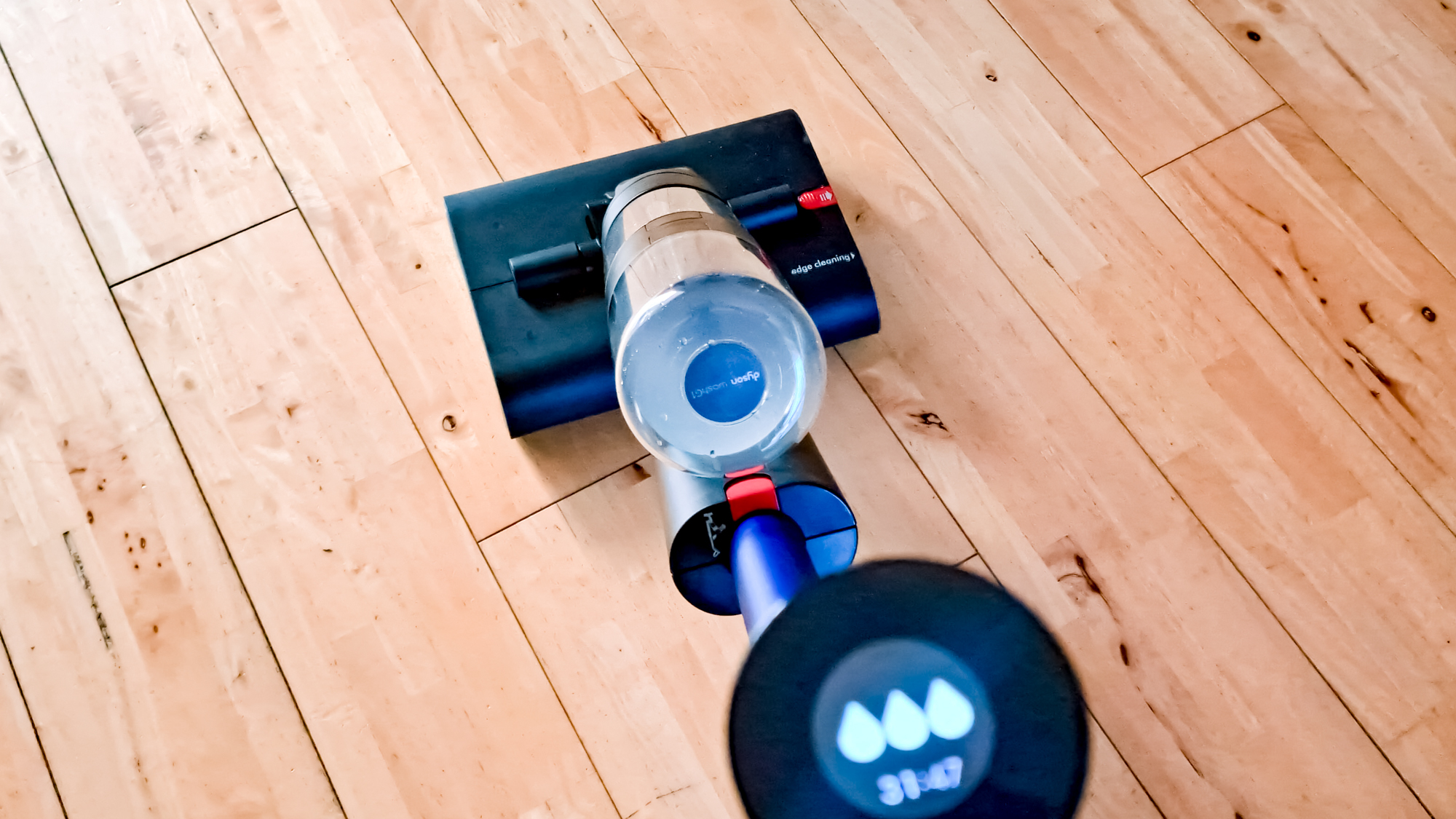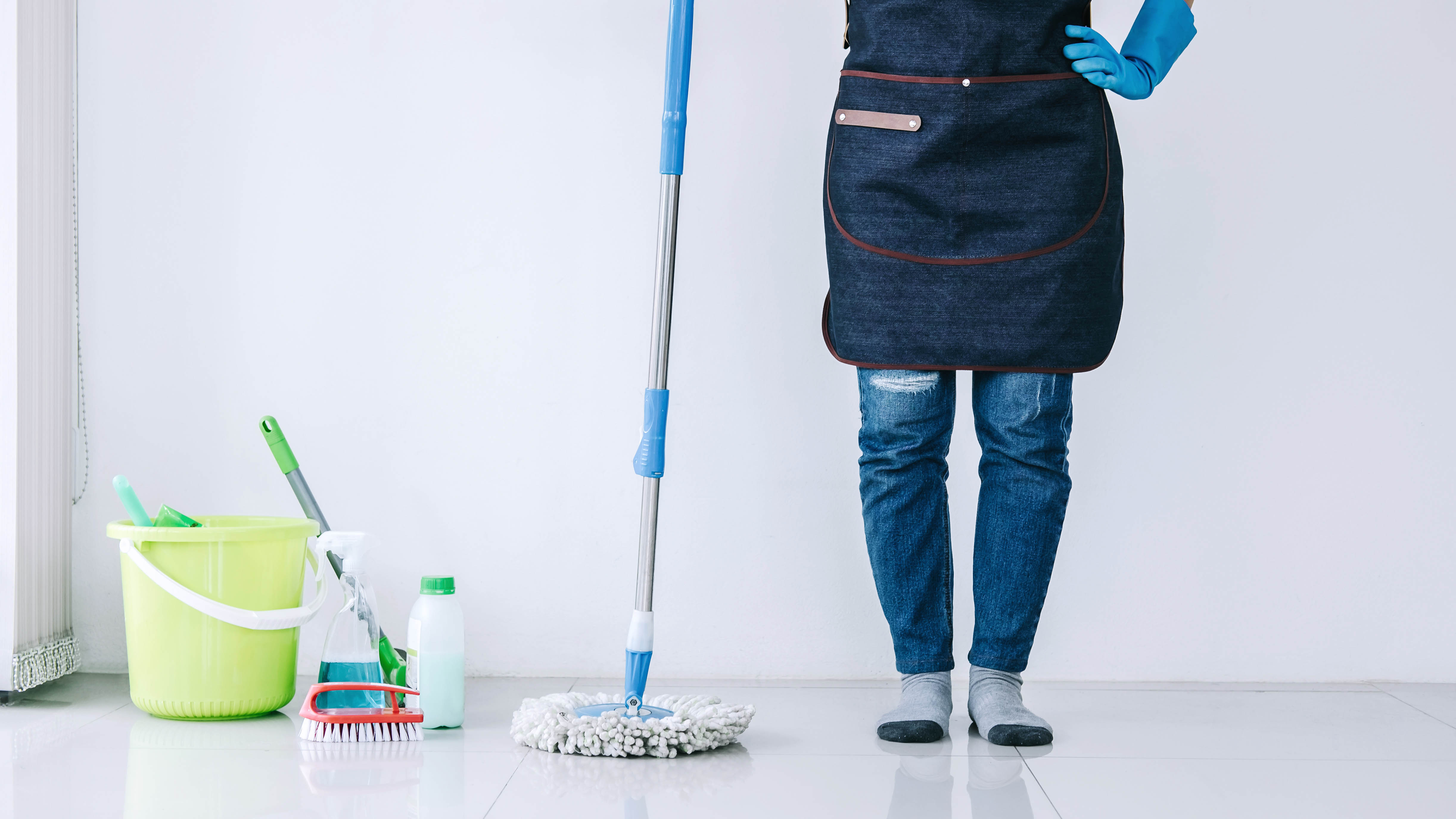Mopping vs wet and dry vacuum — which is better for your floors?

When it comes to cleaning our floors, we all favor quick ways to cut our cleaning time in half. Wet and dry vacuum cleaners have gained huge popularity over recent years, promising to make light work out of mopping chores, and more thorough cleaning results. And as someone who has mainly hardwood and tiled flooring, it can often be time-consuming filling up a bucket with soapy water and carrying it around my home. But are wet and dry vacuums better at cleaning than a traditional mop?
As Homes editor, I've tested several wet and dry vacuums over a few months to see whether I can finally ditch my trusted mop and bucket. This included models such as the Dyson Wash G1, the brand's first dedicated floor washer, which also made the cut for our best vacuum cleaner list.
As a result, I have found pros and cons in using both methods, but which one is better? Here are 3 pros and 3 cons for using a mop and a wet and dry vacuum.
What is a wet and dry vacuum cleaner?

Essentially, these convenient machines are designed to pick up both dry debris and wet liquids from hard floors. These are usually equipped with separate water tank chambers — one for clean water and one for dirty, making it a more hygienic option. Similar to standard vacuum cleaners, these work with a powerful motor to create suction, directed via a hose and nozzle.
You can either buy a corded or cordless type to easily zip around the home with, however, these can be quite heavy. What’s more, some advanced models such as the Tineco Floor One S5 come with an adjustable suction control that allows you to customize the setting to suit the cleaning task, and voice guidance.
3 pros of using a wet and dry vacuum

1. Powerful to quickly tackle any stains
Anyone who has hard flooring knows the pain of trying to keep surfaces dirt, grime and dust-free on a daily basis. This is especially the case if you have children or even pets who are prone to messy spills or muddy footprints.
This is where the sheer power of the wet and dry vacuum has its benefits. I found the responsive suction quick to remove stubborn dirt and marks, in just two sweeps with minimal force. Since these are specifically designed to tackle big messes, as well as debris, sticky crumbs, and spills, these are known to be more powerful than some cordless vacuum cleaners. Which inevitably does all the hard work for you, compared to using a traditional mop .
Get instant access to breaking news, the hottest reviews, great deals and helpful tips.
Also, if you have multiple floor types, it can be tricky to get consistent cleaning results with a mop. However, a wet and dry vacuum can cater to all from hardwood or laminate flooring to ceramic tiles. I found it super easy to use on my wood and marble tile floors, and the automated suction settings allow to to adjust the water levels for each task — which is one of the best features on the Dyson WashG1.
2. Floor dried faster than mopping
Unlike traditional mops that can often leave behind wet patches or streaks on the surface, I was impressed that my floors dried much faster after using a wet dry vacuum. Again, this is due to the powerful brushrolls that can quickly clean and buff the moisture away as it sucks up liquids. And considering that I would usually ban my family from walking into the kitchen or bathroom until the floors are completely dry, this was a bonus.
3. Saves you time
Besides the task of filling up and emptying a bucket each time when using a mop, a wet and dry vacuum cleaner is far more time efficient. Not only does it have a large, mess-free, tank, but its adjustable suction power can tackle stains using the right amount of water needed.
What's more, there is no pausing your cleaning regime mid-way to wring out a dirty mop or refill with clean water. And since there are two separate containers (one for clean and one for dirty), this makes it easier to dispose of quickly. A good bonus when you want to cut your cleaning chore time in half.
Tineco Floor One S5: $449@ Amazon
The Tineco Floor One S5 is ergonomic, slim and doesn’t have the bulkiness of traditional washer vacuums. In our Tineco Floor One S5 Extreme review, we said the Editor's Choice vacuum is a powerful, cordless cleaner that can vacuum and mop hardwood floors with ease. It struggles a bit with edges and corners, but for those with mainly hardwood flooring in their homes, this is an excellent choice.
3 cons of using a wet and dry vacuum

1. Bulky head can’t tackle awkward spaces well
Typically, wet and dry vacuums are equipped with a bulky head, and no extra attachments for other areas. As a result, it couldn’t properly clean awkward corners underneath my kitchen cabinets, or underneath my low-rise sofa. In addition, it wasn’t suitable for cleaning baseboards, which my mop could do with one swipe.
Plus, if you have a home with plenty of stairs, it can be quite heavy (especially with a full water tank) to carry up and down the floors — making it impractical for daily use. In which case, I still needed to get the mop out to get to work on those hard-to-reach areas — defeating the purpose.
2. You can only use cold water
Now this is down to personal preference, but I’ve always used hot or lukewarm water to get my floors clean and sanitized. After all, steam is known for killing 99.9% of bacteria and germs without the need for chemicals, according to experts.
However, you can only use cold or room temperature water inside a wet and dry vacuum. You’re also not allowed to use any cleaning detergent (except for their own brand solution), to avoid creating suds inside the mechanism, and risk damage.
And while I was impressed with the spotless results, I questioned how germ-free my floors actually were — and missed my fragrant detergent.
3. You need to charge a battery
As with all cordless appliances, you’re reliant on a fully-charged battery whenever you need it. And there’s nothing worse than a dying battery halfway through your cleaning chores. Typically, wet and dry vacuums come with a 35-minute battery life (on a normal setting). So if you have a palatial home, or dealing with heavy-duty messes to clean up, this might be somewhat limiting.
What is a traditional mop?
This popular cleaning tool has been around for the longest time. Traditionally, this consists of a mop head, handle and a bucket to fill with water. Nowadays, there are various types of mop, such as the spin mop cleaning system or those using washable microfiber pads.
3 pros of using a mop

1. Versatile
Generally, traditional mops can be used to clean any type of surface, including baseboards and some walls. It's also easier to get into any nook and crannies, and tackle awkward corners or angles more easily. Which also makes it ideal for raised or ridged floor tiles or surfaces that a wet and dry vacuum cleaner may not reach.
2. Easy to use
Mops are not reliant on electrical power or battery to operate, and can be used at any time. It's also lightweight and easy to carry around the home and transport. And since it's not likely to malfunction, it's easy to maintain.
3. Cheap and cheerful
Unlike expensive wet and dry vacuum cleaners, mops are affordable to buy and to run.
The average cost of a wet dry vacuum can start from $199 right up to $599, while a quality mop and bucket can start from as little as $20. This makes it a more cost effective option.
O-Cedar EasyWring RinseClean Microfiber Spin Mop & Bucket: $49 @ Amazon
If you want to splash out on a quality mop, this is a great choice. It comes with two separate chambers for clean and dirty water. They also have removable microfiber mop heads, these are suitable to use for every surface, and are removable to throw in the washing machine.
3 cons of using a mop

1. Time-consuming
Mopping can be time-consuming and requires several steps, such as filling up a bucket, wringing out the mop and then changing over the water. It also might take some time to carry the bucket carefully around the home, or up and down stairs.
2. Dealing with dirty water
Another con is that you'll be getting your hands dirty compared to handling a self-contained canister. Plus, if your bucket is not separated into two sections, once you've refreshed the mop head you'll be spreading dirty water around your home.
In addition, when was the last time you cleaned your mop? The fibers in mops are known to harbor germs and bacteria, which can then be transferred over the very surfaces that you're trying to clean. As a result, you would need to ensure the mop head is disinfected regularly, or replaced.
3. Not as powerful
Compared to the powerful suction of a wet and dry vacuum cleaner, mops may not get floors as spotless and germ-free. This is mainly because it relies on manual labor, which can vary, as opposed to the consistent power of a vacuum cleaner.
The bottom line
The bottom line
Whether you choose a traditional mop or a wet and dry vacuum cleaner will depend on personal preference, lifestyle and the size of your home.
Both vacuum mops and traditional mops have their pros and cons. There is no disputing the incredible power of a wet and dry vacuum to quickly tackle stubborn grime and dirt. And if you have mainly hard floors and want to save time with a powerful cleaning solution, a wet and dry vacuum is a worthwhile investment.
However, if you prefer a fuss-free, more versatile and cheaper option, a traditional mop may suit your needs. Before buying, it's always worth doing research and reading reviews on our best vacuum cleaner guide before making a final decision. In any case, you'll have spotless and sparkling floors.

As the Homes Content Editor, Cynthia Lawrence covers all things homes, interior decorating, and garden-related. She has a wealth of editorial experience testing the latest, ‘must-have’ home appliances, writing buying guides and the handy ‘how to’ features.
Her work has been published in various titles including, T3, Top Ten Reviews, Ideal Home, Real Homes, Livingetc. and House Beautiful, amongst many.
With a rather unhealthy obsession for all things homes and interiors, she also has an interior design blog for style inspiration and savvy storage solutions (get rid of that clutter!). When she’s not testing cool products, she’ll be searching online for more decor ideas to spruce up her family home or looking for a great bargain!


